Taos Center for the Arts Night of a Thousand Stars
~~
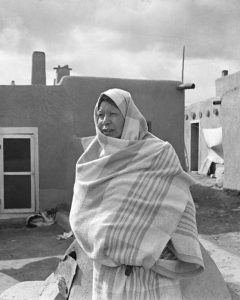
Taos Pueblo adult female past Arthur Rothstein, 1936.
Taos, New Mexico, the county seat of Taos County, is located in the northcentral part of the state in the midst of the Sangre de Cristo Mountains. The boondocks derives its name from the native Taos language pregnant "identify of red willows." Its long history dates dorsum hundreds of years and today proudly incorporates three cultures — Native American, Anglo, and Hispanic — into a beautiful urban center with a heritage of colorful people.
The Taos Valley, with its two great Pueblos, the erstwhile boondocks of Fernando de Taos, and the still more than ancient settlement known equally Ranchos de Taos, is one of the most fascinating and historical points in the West.
Most of Taos County's eastern boundary is occupied past the Taos Range of the Rocky Mountains, and Taos Valley itself is one of the most picturesque in existence. On the e, information technology is surrounded by a one-half-moon of mountains, with no foothills extending into the mesas to diminish the scene'south grandeur. Xi streams result from these mountains and across the valley in a westerly management, and the Rio Grande cuts through it in a 500 anxiety deep coulee.
Long earlier European explorers discovered the region, it had been inhabited as early as 12,000 BC when early inhabitants roamed the area, hunting big mammals, such as mammoths, and gathering wild foods for subsistence. By 3,000 BC, the people began to adopt the thought of agriculture from neighbors in Mexico, which began to restrict their movements and develop long-term communities.
The ancestors of the Pueblo people, commonly known as the Anasazi, were the start permanent inhabitants of Taos Valley. Room blocks and pit houses in the Taos area show to their presence since 900 AD. Around 1200 AD, they aggregated into modest above-ground structures of l-100 rooms. The Taos Pueblo that continues to stand today was probably congenital betwixt A.D. 1300 and 1450.
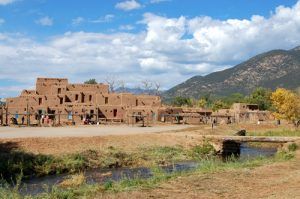
Taos Pueblo, New Mexico. Kathy Weiser-Alexander.
Throughout its early on years, Taos Pueblo was a primal point of trade between the native populations along the Rio Grande and their neighbors to the northwest, the Plains Tribes. Taos Pueblo hosted a trade fair each fall later the agricultural harvest. This off-white impressed the beginning Spaniards who made contact with the ancient pueblo. Somewhen, merchandise routes would link Taos to the northernmost towns of New Spain and Mexico's cities via the famed Chihuahua Trail.
The outset Spanish visitors to Taos Pueblo arrived in 1540 as members of the Francisco Vásquez de Coronado expedition, which stopped at many of New Mexico's pueblos searching for the rumored Seven Cities of Golden. At the time, Hernando de Alvarado described the pueblo as having adobe houses built very close together and stacked five or six stories high. The homes became narrower as they rose, with each level's roofs providing the floors and terraces for those above. Surrounded by a depression defensive wall, the community had two main clusters of buildings, one on each side of the Rio Grande, which provided water for the residents and their crops.
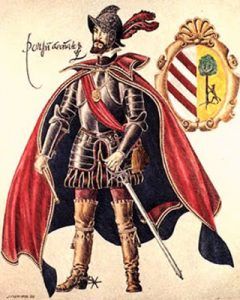
Juan de Onate
The first Castilian-influenced compages appeared in Taos Pueblo later Fray Francisco de Zamora came at that place in 1598 to establish a mission under orders from Spanish Governor Don Juan de Oñate.
The village of Taos, first called Fernando de Taos, was established in nearly 1615, following the Spanish conquest of the Indian Pueblo villages by Geneva Vigil. Initially, the relations of the Spanish settlers with Taos Pueblo were amicable. All the same, resentment of meddling by missionaries and demands for a tribute to the church and Spanish colonists led to several revolts. Taos would become the center of many of the pueblo rebellions against the Spanish, the first of which most occurred in 1609 when Governor Don Juan de Oñate was accused of throwing a young Taos Indian from a rooftop. However, Oñate was presently removed from part. Another pocket-sized revolt was quickly subdued in 1613. But, these small insurgencies did not stop the determined Spanish priests and colonists. Around 1620, the start Catholic Church in the pueblo, San Geronimo de Taos, was synthetic.
Reports from the menstruum signal that the native people of Taos resisted the building of the church and the imposition of the Catholic religion. Throughout the 1600s, cultural tensions grew between the native populations of the Southwest and the increasing Spanish presence. In 1631, another event occurred in the rebellion of the Spaniards when a resident missionary and the soldiers who escorted him were attacked and killed. Tensions connected to grow, and in 1640, the Taos Indians killed their priest and several Spanish settlers and fled the pueblo. The people would non return to their pueblo for more than than 2 decades, in 1661.
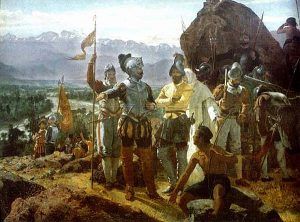
Spanish Conquistadors
In the 1670s, drought swept the region, which caused famine amid the pueblos and provoked increased attacks from neighboring nomadic tribes. Due to the number of attacks, the Castilian soldiers were not always able to defend the pueblos. At about the aforementioned fourth dimension, European-introduced diseases were ravaging the pueblos and greatly decreasing their numbers. Becoming increasingly dissatisfied with the Spanish, the Puebloans turned to their sometime religions, provoking a wave of repression from the Franciscan missionaries. While the missionaries had previously tended to ignore the occasional pueblo ceremonies as long equally the people made some effort to attend mass, the Puebloans renewed vigor towards their religions caused Fray Alonso de Posada to forbid Kachina dances past the Pueblo Indians and ordered the missionaries to seize every mask, prayer stick, and figure they could lay their easily on and burn them. Furthermore, the Indians were forbidden, on pain of decease, to practice their native religions. When some Spanish officials tried to curb the Franciscans' power, they were charged with heresy and tried before the Inquisition.
In 1675, the tension came to a head when Governor Juan Francisco Treviño ordered the abort of 47 medicine men and accused them of practicing witchcraft. 4 of the men were sentenced to be hanged – three of those sentences were carried out, while the fourth prisoner committed suicide. The remaining men were publicly whipped and sentenced to prison. When this news reached the Pueblo leaders, they moved in force to Santa Fe, where the prisoners were held. Because a big number of Spanish soldiers were abroad fighting the Apache, Governor Treviño released the prisoners. Among those who were released was a medicine human being from the San Juan Pueblo (now known equally Ohkay Owingeh), named Popé, who would soon become the leader of the Pueblo Rebellion. Popé then moved to Taos Pueblo and began plotting with men from other pueblos to drive the Spaniards out.
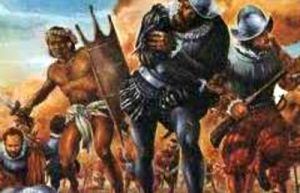
Pueblo Revolt
Before long, a well-coordinated effort of several pueblo villages was established in August of 1680. Throughout the upper Rio Grande basin northward of El Paso to Taos, the Tewa, Tiwa, Hopi, Zuni, and other Keresan-speaking pueblos, and even the non-pueblo Apache planned to rise against the Spanish simultaneously.
On August 10, 1680, the attack, known as the Pueblo Revolt, was commenced by the Taos, Picuri, and Tewa Indians in their respective provinces confronting 40 Franciscans and another 380 Spaniards, including men, women, and children. The Spaniards that were able to escape fled to Santa Iron and the Isleta Pueblo, one of the few pueblos that did non participate in the rebellion. Popé'southward warriors, armed with Spanish weapons, then besieged Santa Fe, surrounding the city and cutting off its water supply. New Mexico Governor Antonio de Otermín, barricaded in the Governor's Palace, shortly called for a general retreat. On August 21st, the remaining 3,000 Spanish settlers streamed out of the capital metropolis and headed for El Paso, Texas. Assertive themselves the only survivors, the refugees at the Isleta Pueblo also left for El Paso in September. In the meantime, the pueblo people destroyed about of the Spanish homes and buildings. The Taos Indians again destroyed San Geronimo and killed ii priests.
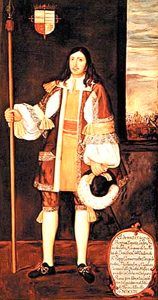
Governor Diego de Vargas
After the Spanish Reconquest of 1692, Taos Pueblo connected armed resistance against the Spanish until 1696, when Governor Diego de Vargas defeated the Indians at Taos Canyon. He soon persuaded the Taos Pueblo Indians to drop their arms and come back out of the mountains.
In 1723, the Castilian government forbade trade with the French, and limited trade with the Plains Tribes but to Taos and Pecos, thereby giving rise to the annual summer trade fairs at those locations where Comanche, Kiowa, and others came in great numbers to trade captives for horses, grain and trade goods from Chihuahua.
In 1776, at the time of the American Declaration of Independence, there were an estimated 67 families with 306 Spaniards in the Taos Valley. At that time, the Ranchos de Taos area was the most populous. That same yr the first Castilian church was congenital in Ranchos de Taos. A few years earlier, the start church in the area was being built in 1772. The Franciscans supervised the structure of the historic San Francisco de Assisi Mission Church that was finally completed in 1816.
During the 1770s, Taos was repeatedly raided by Comanche, who lived on the plains of what is now eastern Colorado. Juan Bautista de Anza, governor of the Province of New Mexico, led a successful punitive expedition in 1779 confronting the Comanche.
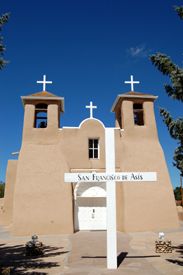
San Francisco de Assisi Mission Church in Ranchos de Taos, New Mexico, nonetheless
serves a congregation today. Photograph by Kathy Weiser-Alexander.
The erection of the church building at Fernando de Taos was begun in 1796, but it was non completed until 1806. The aboriginal church at the Pueblo, which was ruined during the Taos Revolt in 1847, was the headquarters of the Roman Cosmic diocese. Castilian/native relations inside the pueblo became amicable for a cursory menstruum as both groups found a common enemy in the invading Ute and Comanche tribes. However, resistance to Catholicism and Spanish culture was still strong. Even so, Spanish religious ideals and agricultural practices subtly worked their fashion into the Taos customs, largely starting during this time of increased cooperation between the ii cultural groups.
Between 1796 and 1797, the Don Fernando de Taos Country Grant gave land to 63 Spanish families in the Taos valley. A more formal settlement was established to the northeast of Ranchos de Taos, with a fortified plaza and adobe buildings, surrounded by residential areas. Homes were built in large quadrangles that offered a fortress-similar structure. Hostile raiding Indians from outside the Taos area were thwarted in their attempts to enter the hamlet. Sentries stationed at the corners of the fortified village kept vigil 24-hour interval and nighttime. A huge gate offered the merely means of entry and exit to the Plaza. The enclosure served every bit a refuge for livestock at dark, and merchants used the expanse to display their wares during trade fairs.
Taos was, for many years post-obit the American occupation, the main political tempest-middle of the Territory. The presence in that location of such men as Charles Bent, the commencement Governor; Colonel Christopher "Kit" Carson, the famous scout and guide; Colonel Ceran St. Vrain, the well-known merchant; "Don Carlos" Beaubien, i of the original proprietors of the notorious Maxwell Country Grant and the first Chief Justice of New Mexico; Begetter Martinez, a demagogue, traitor, conspirator against peace and every bit great a rascal as always, who remained un-hanged in New Mexico, whether viewed from a political or moral standpoint — such individuals as these gave the customs a position in Territorial diplomacy equal to that of Santa Fe, the capital.
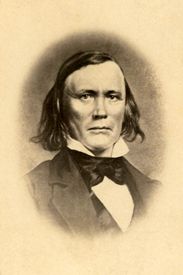
Kit Carson
Along with these famous names, there were dozens of other French, American, and Canadian trappers operating in Taos County. A brisk fur trade began, bringing notwithstanding another element — the mountain men — to the Taos trade fair. By that fourth dimension, the Taos Valley was well populated with livestock, agronomics, and people who supplied Mexico with inexpensive appurtenances. Goods also came into Taos, such as the first printing press west of the Mississippi River in 1834, to print books for the co-educational school, which Padre Antonio Jose Martinez founded. In 1835, the padre began printing the kickoff paper, El Crepusculo, which was the predecessor to The Taos News. In 1840, some twenty,000 Rio Grande wool blankets were exported south to Mexico.
In 1842 Padre Martínez, later giving him instruction, baptized Kit Carson as a Cosmic so he could become engaged to marry Josefa Jaramillo. The following yr, Kit and Josefa married, and Kit purchased a house from the Jaramillo family every bit a wedding present for his new helpmate. The house, built in 1825, served as Carson's abode until 1868, and today is the Kit Carson Home and Museum. Three years later, in 1846, Colonel Stephen W. Kearny with his "Army of the West" occupied New Mexico for the The states. Charles Aptitude of Taos was appointed every bit the first American Governor. That same year, business remained brisk in Taos every bit 1.seven million dollars in beaver and other furs were traded through Taos.
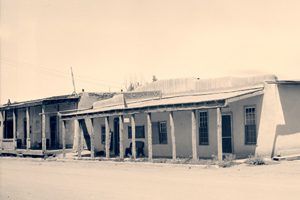
Kit Carson House in Taos, New Mexico
New Mexico formally became a territory of the Us in 1847 with the signing of the Treaty of Guadalupe Hidalgo. However, many of the native Mexicans and Indians were not happy with this event. The Mexicans in the Taos area resented the newcomers and enlisted the Taos Indians to assist them in an insurrection. Mexican Pablo Montoya and Tomasito, a leader of the Taos Pueblo Indians, led a strength of Mexicans and Indians who did not want to get a part of the United states. Charles Bent, the new American governor who was headquartered at Taos, was killed and scalped in January 1847 along with many other American officials and residents. The rebels so marched on Santa Fe, but the response of the American Army was immediate. A strength of more than than 300 soldiers from Santa Fe and Albuquerque quickly rode to Taos, and after battles in Santa Cruz and Embudo, the rebels were soundly defeated. The remainder of the Mexicans and Indians took refuge in the San Geronimo Mission Church building. The American troops bombarded the church, killing or capturing the insurrectionists and destroying the physical construction. Effectually 1850, an entirely new mission church was constructed near the w gate of the pueblo wall.
In 1852, Taos and other counties in New Mexico were redefined from an earlier division made in 1846, which was based on an sometime Mexican regime Partido and fabricated Taos the county seat of Taos Canton.
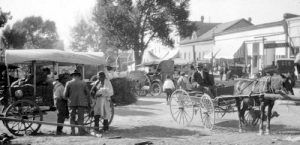
Onetime Taos, New United mexican states
Taos Valley flourished during this catamenia every bit other cultures constitute their way into the territory. Taos was an excellent trade center for the region but, with honest merchants and families, also came criminals. Before the Civil War, it became a hotbed of many of the early on conspiracies against the American government. After the Civil War, well-nigh criminals moved on, and the city of Taos was mostly peaceful. All the same, there was one great exception in a notorious character who went by the name of "Colonel" Thomas Means. A surveyor by profession, he came to New United mexican states Territory soon afterwards the inauguration of civil authorities past the Americans. He lived in Colfax County for some time, and for years was more or less identified with the tragic episodes which marked the early on history of the infamous Maxwell Land Grant. He finally settled downward in Taos, where he made life ane continuous round of misery for all who were forced into contact with him. He exhibited an insolence and confrontational disposition that constantly precipitated him into problem until he became such a nuisance to the more than peaceably inclined inhabitants as to return desperate measures necessary. He would not but grossly insult and frequently set on everyone who came within his reach, but he beat his wife and then desperately on innumerable occasions that her life was in jeopardy.
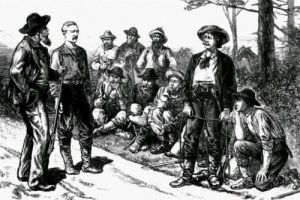
Vigilantes
Finding that their appeals to courts of justice were to no avail, in 1868, several citizens decided to organize that common frontier establishment known as a Vigilance Committee and put an end to "Colonel" Means and all his meanness. Though the vigilantes warned him of his inevitable fate if he connected his violent actions, Ways ignored the threat. On January ii, 1867, when he drew his knife, fired his pistol at several people, assaulted and nigh killed his wife following a "big spree," he was shortly arrested. That night, a grouping of 15-twenty heavily armed men "in disguise" entered the room where Means was beingness held and forcibly removed him from the custody of his guards. The vigilantes then carried him to an adjoining room, which served as the county courthouse, and hanged him from a heavy rafter. The coroner's jury described Means equally "not deserving of the sympathy of anyone, being as he was altogether a unsafe character, continually threatening the lives of peaceable citizens, without stardom and even the lives of members of his own family and innocent children." The conclusion was that Means had died at the hands of "persons unknown." The adjacent day was one of general rejoicing that the community had been summarily rid of one of its nigh disagreeable and dangerous factors. Thus ended the career of 1 of the near widely known, and at i time, one of the virtually influential men of northern New Mexico.

Gold Prospector in New Mexico
The 1880s brought a different type of newcomer to the Taos Valley when aureate and rumors of gold, silvery, and copper spread throughout the region. In 1866, gold had been institute in Elizabethtown, New Mexico, some 30 miles northeast of Taos, and in the 1870s, miners began searching for aureate in the Red River area. The fever spread, and from 1880 to 1895, the Rio Hondo, which begins loftier in the Sangre de Cristo Mountains near what is at present Taos Ski Valley, was actively searched by placer miners. Mining, however, was not productive in the Taos expanse.
In 1898, 2 young artists from the Eastward named Ernest Blumenschein and Bert Phillips discovered the valley later their carriage broke downwards due north of Taos. They decided to stay, absorbed past the beauty of the surface area. As word of their discovery spread throughout the fine art community, they were joined past other associates. This was the start of Taos' history and reputation equally an artist's community.
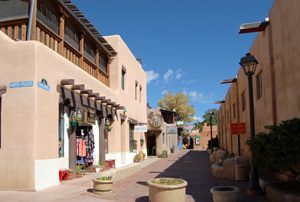
Downtown Artists' Community in Taos, New United mexican states past Kathy Weiser-Alexander.
In 1912 New Mexico became the 47th state. Three years later, in 1915, the Taos Social club of Artists was formed, which unwittingly helped institute one of Taos' leading sources of acquirement in the 20th century — the tourist trade. In 1917, Socialite Mabel Contrivance Luhan arrived and somewhen brought to Taos artistic luminaries such as Ansel Adams, Willa Cather, Aldous Huxley, Carl Jung, D.H. Lawrence, Georgia O'Keeffe, Thornton Wilder, and Thomas Wolfe.
On May nine, 1932, the Taos County Courthouse and the other buildings on the north side of the Plaza were destroyed by one of a series of fires in the early 1930s. This led to the incorporation of the Town of Taos on May 7, 1934, and establishing a burn department and public water system. That aforementioned year, a new Spanish-Pueblo way courthouse was built with partial funding from the Works Progress Assistants. In 1956, the Taos Ski Valley was established, bringing more than tourism to the valley. Earlier long, other expanse ski resorts as well sprang upwardly nearby – Red River, Sipapu, and Angel Burn.
In 1965, the 2d-highest suspension bridge in the U.S. highway organization was built spanning the Rio Grande Gorge. Information technology was called the "bridge to nowhere" while it is being congenital because the funding did not exist to keep the road on the other side. Still, its magnificence tin can exist seen today along US Highway 64, heading n to Colorado.
During the 1960s and 1970s, Taos became known for beingness a Hippie community. The city was the perfect place for the 1960s counterculture to express itself, as Taos had long been accustomed to blending cultures. Taos and the rest of New Mexico take long been known as an arty and spiritual place. By 1969 there were at least half dozen communes in the Taos surface area, and some say as many every bit 25. One of the communes' leaders took to the stage at the Woodstock festival in 1969, inviting all to his commune and cute Taos — and the came. Although the commune era peaked in the early on 1970s, many "old" hippies gradually became part of the Taos customs, and their sensibilities remain today.
Unfortunately, on July 4, 2003, the Taos expanse suffered a burn in the nearby mountains ignited past lightning. Called the Encebado Fire, information technology was inside a mile of the historic Taos Pueblo buildings. Information technology took more a thousand firefighters thirteen days to incorporate the 5,400-acre blaze. Fortunately, there was no loss of life or structures, merely the Rio Pueblo watershed and the sacred pueblo land volition accept a generation to recover.
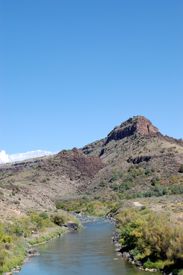
Rio Thousand River in Taos Valley, New Mexico past Kathy Weiser-Alexander.
Today, Taos is known worldwide past artists, outdoor enthusiasts, and historians. The center of the Taos Downtown Celebrated District is the Taos Plaza. Just west of that is the Our Lady of Guadalupe Church. North of the Taos Plaza is the Governor Charles Aptitude Business firm and the Taos Inn. Further north in Taos is The Bernard Beimer House. On the southwestern border of the Taos Historic district is La Hill Plaza Celebrated District. East of the plaza on Kit Carson Route is the Kit Carson Firm and museum.
Only two miles to the northeast of Taos, under the shadows of great mountains and occupying both sides of Red Willow Creek, is the pueblo of Taos, with its great terraced buildings, presenting one of the most primitive illustrations of Indian compages. It has been occupied for nearly a millennium by the Tiwa Indians, who occupy a fertile tract of 17,000 acres, a Spanish government grant. It was originally much larger, simply for protection against the Comanche, Kiowa, Cheyenne, and Ute, who formerly caused them a great annoyance, they gave the east part of their grant to Mexican settlers, with the understanding that the latter would help them in repelling invasions from Taos Canyon. It is the most northern of the New Mexico pueblos, which in some places are 5 stories loftier and is a combination of many individual homes with mutual walls. There are over ane,900 people in the Taos Pueblo community, though many modern homes are nearby. There are about 150 people who live at the pueblo year-round. The Taos Pueblo was added every bit a UNESCO Earth Heritage Site in 1992.
Ranchos de Taos is located most four miles southwest of Taos, is in the center of fertile agricultural and fruit lands, and once had several flour mills, schools, and missions.
Taos is now a customs overflowing with a long, proud history that features numerous historic buildings, arts and civilisation, recreational opportunities, and about 5900 people.
© Kathy Weiser-Alexander/Legends of America, updated March 2021.
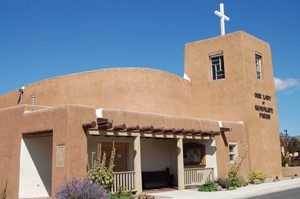
Our Lady of Guadalupe Church in Taos, New United mexican states by Kathy Weiser-Alexander.
Also Meet:
Ancient & Modern Pueblos – Oldest Cities in the U.S.
New Mexico – Land of Enchantment
The Tiwa Tribe – Fighting the Spanish
Pueblo Indians – Oldest Culture in the U.S.
Sources:
Anderson, George B., History of New Mexico: Its Resource and People, Volume ii, Pacific States Publishing Co, 1907
National Park Service
New Mexico Magazine
Snow Mansion
Taos County Historical Society
Taos News
Taos Walking Tour
Tórrez, Robert J., Myth of the Hanging Tree: Stories of Law-breaking and Punishment in Territorial New Mexico, UNM Press, 2008
Wikipedia
Source: https://www.legendsofamerica.com/nm-taos/
0 Response to "Taos Center for the Arts Night of a Thousand Stars"
Post a Comment